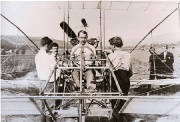E-Archive
Off the Beaten Track
in Vol. 22 - July Issue - Year 2021
The Patent Wars

The Wright brothers

Glenn Curtiss before take-off in the Scientific American competition
On December 17th 1903, Wilbur and Orville Wright made the first controlled and powered human flight in a heavier-than-air aircraft. However, instead of dedicating themselves to developing and improving on their original design over the following years, the brothers spent enormous amounts of time and money in drawn-out legal battles in order to defend their patents. The ensuing courtroom conflicts severely hindered the growth of the aircraft industry in the United States. What happened?
The answer lies in a series of bad business decisions made once they had developed a plane suitable for the market. Before their successful powered flight in 1903, the brothers had built and flown several models of gliders. Attempts at human-piloted flight had been ongoing on both sides of the Atlantic for several decades, but the primitive models of gliders and balloons lacked flight control and therefore were totally useless. In 1902, the Wrights developed a glider with a revolutionary tri-axis control system that incorporated a “wing-warping” mechanism*. By twisting and shaping the wing, it was possible to maintain balance and directional control during flight much like a bird adjusting the contour of its wings. It took several attempts with an expert patent lawyer before a patent was finally granted in May 1906. The patent was construed to include gliders as well as powered aircraft. It also protected a combination of wing warping and a movable vertical rudder, as well as an alternative control system based upon rigid wings and freely operating between-the-wings ailerons, although their airplane did not actually mount ailerons. The Wright brothers were confident that their patent was airtight and that anyone wishing to produce any type of powered aircraft would have to pay them royalties and licensing fees. The lawyer then turned his attention to having the original patent recognized and applied in Europe. However, over three years had passed between the first application and the final granting of the patent, and in the meantime other players had appeared in America and Europe, some of them with patents of their own.
Glenn Curtiss was a young and promising mechanical engineer. In common with the Wright brothers, Curtiss designed and built his own bicycles. Contrary to the introvert Wright brothers, Curtiss was bold and outgoing. He was fascinated by the advent of the gas-combustion engine and began manufacturing his own lightweight and powerful one-cylinder engines, soon mounting them on his bicycles. Curtiss raced his motorcycles and reaped trophies and medals. He was drawn to aviation when he realized how his lightweight engines could benefit airplanes. He started designing and building entire aircraft on his own. Instead of applying the wing-warping mechanism, Curtiss placed controllable hinged tabs near each wing tip, a solution that greatly simplified aircraft design, provided more mechanical reliability, and also offered better steering control. These tabs became known as “ailerons”.
Curtiss’s engines attracted the attention of famous inventor Alexander Graham Bell, who realized that those small, lightweight engines were the perfect solution for lifting an airplane off the ground. Bell invited Curtiss to join him and other inventors in the newly-founded Aerial Experiment Association (AEA), a private research and development group. Curtiss built the June Bug, a bi-plane equipped with a 40 hp, V8 Curtiss engine. Bell entered the June Bug in a contest sponsored by Scientific American that offered a trophy and prize money for the first heavier-than-air machine capable of flying at least one kilometer in front of judges. Curtiss flew over 1.5 km and earned instant nationwide fame and glory. This provoked the anger of the Wright brothers, who brought the first of many lawsuits against Curtiss and other inventors for patent infringement. Over the following years, the Wrights were involved in a dozen different lawsuits in the U.S. and nearly two dozen in Europe, but their downfall was their obsession with secrecy. They were unwilling to show their invention to anyone who might steal its design. Prospective buyers balked at the large deposit required only to view the aircraft. The lawsuits dragged on and by April 1914, the Curtiss Aeroplane Company had surpassed the Wrights to become the largest airplane manufacturer in the United States. In October 1915, the Wright Company was sold to a group of investors and a year later it merged with another company to become the Wright-Martin Company. The patent wars were settled in 1917 and in 1929, Curtiss and Wright merged to become the Curtiss-Wright Corporation, at present one of the world’s leading aviation and aerospace conglomerates.
By Giovanni Gregorat, Contributing Editor MFN



























